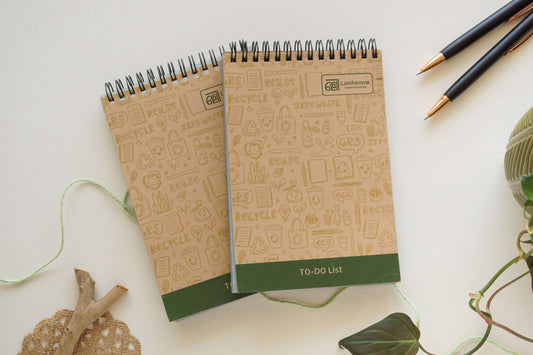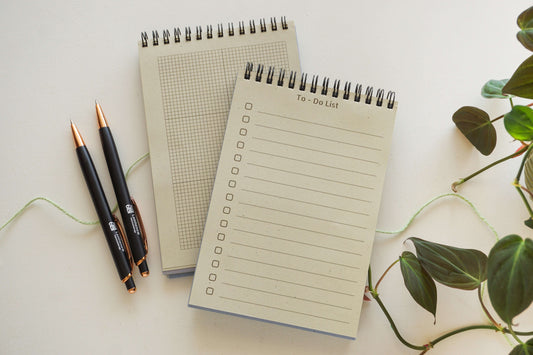
The Hidden Benefits of Journaling: What Science Really Says About Writing Things Down
Journaling does more than just help organize our thoughts - its benefits are remarkable. Research shows that 68% of people who journal saw better health outcomes compared to those who didn't. This simple daily practice can deeply impact our mental and physical health.
Scientists have proven that journaling helps people of all backgrounds. The data reveals reduced mental distress and better overall wellbeing among those who journal regularly. People who journal tend to visit doctors less often and show fewer symptoms of chronic conditions like asthma and arthritis. Some studies even suggest it might boost how well vaccines work. The mental health advantages stand out the most. People report much lower levels of depression, anxiety, and hostile feelings - especially those dealing with high stress.
This piece breaks down what science tells us about putting our thoughts on paper. You'll learn about the brain processes behind journaling, the different techniques researchers have studied, and solid evidence from controlled trials. Whether you want to grow personally, do better academically, or support your therapy, knowing these proven benefits will help you use this powerful tool better.
The science behind journaling and mental health
The brain responds in remarkable ways when we put pen to paper. Research shows that journaling changes how our brain works and helps us process information better. We can make connections more easily too. Let's explore what happens in our brain when thoughts become written words.
How journaling affects the brain
Our brain lights up in multiple regions when we journal. This creates a beautiful symphony of neural activity. Brain scans reveal that people who wrote about their feelings showed better emotional control compared to those who wrote about neutral topics. Writing involves our complete sensory system. We feel the paper, watch words form, and smell the ink. This full sensory experience boosts brain activation.
Journaling brings impressive cognitive rewards. Research proves that writing about worries or negative experiences frees up mental space. This allows better focus on immediate tasks. Students who journal before exams often score higher because their brains have more resources to tackle test questions.
The brain treats what we write as important information and moves it from short-term to long-term memory. This matters a lot to students in India where academic pressure runs high and memory-boosting techniques hold great value.
Role of Broca's area and the amygdala
Broca's area and the amygdala work together to create journaling's powerful benefits. Broca's area, which controls language production, becomes very active during writing. This brain region helps us turn feelings and thoughts into words.
The amygdala serves as our brain's emotional processing hub and triggers fight-or-flight responses during stress. Functional MRI studies show stronger connections from Broca's area to the amygdala when processing emotions. People who worry more showed higher activity in Broca's area during tasks that required inhibition.
Research points to this connection as a successful top-down control mechanism. One study noted, "Present findings indicate that individuals with elevated trait worry employ a mechanism of top-down control in which communication from Broca's to amygdala fosters successful compensation for interference effects". Writing activates Broca's area, which then helps calm the amygdala and reduces emotional reactions.
Emotional regulation through writing
Writing offers powerful ways to control emotions. Research shows that writing about negative past experiences reduces anxiety and depression while improving physical health. This works through several key paths:
- Emotional processing: Writing lets us express emotions freely without judgment and helps us understand our feelings better
- Breaking rumination cycles: Writing stops obsessive thinking patterns that come with stress and anxiety
- Cognitive reorganization: Putting thoughts on paper helps organize scattered ideas and find solutions to problems
These benefits come from emotional release, better thought processing, and reduced emotional suppression. Writing turns painful experiences into words on paper. This lets us look at them from different angles.
Research confirms that writing creates real benefits by reaching deep into our feelings. "By writing, the subject can develop thoughts to accept the existing situation, focusing on things that are more positive". Regular journaling helps calm our amygdala as we learn to understand our emotions better.
The benefits reach into self-awareness, which grows stronger with practice. Writing works well to boost self-awareness because we can do it daily. Reading our old entries gives us deeper insights into our thoughts, feelings, and beliefs. Better self-awareness lifts our confidence and helps us accept others more easily. This can improve both personal and work relationships.
Writing serves as a budget-friendly mental health tool in India, especially where other resources might be scarce. It works well in both rural and urban areas.
Types of journaling studied in research
Scientists have looked at many ways people journal to learn how different writing styles help our mental and physical health. Research consistently points to three main journaling methods. Each method has its own approach and benefits.
Expressive writing
Back in 1986, Pennebaker created expressive writing where people write about their deepest thoughts and feelings about traumatic or stressful experiences. The basic method is simple - write for 15-20 minutes each day for 3-5 days straight. Unlike regular diary writing, this well-laid-out approach lets you explore deep emotions without worrying about grammar or spelling.
The results are amazing. Studies show that people who wrote about both their feelings and facts about traumatic events had better immune systems, improved moods, and visited health centers less in the next six months. This type of writing also helps reduce anxiety, ease depression, and lower post-traumatic stress.
Three key theories explain why expressive writing works so well:
- Inhibition theory: Your body uses energy to hold back thoughts and feelings. Writing releases this tension and eases physical strain
- Habituation: When you face stressful thoughts repeatedly, they gradually lose their emotional power
- Narrative construction: Turning thoughts into clear stories helps your brain process difficult experiences better
This writing style helps more than just people with clinical issues. Studies show it helps people find jobs faster after losing work, deal better with homosexual orientation, and helps women see their bodies more realistically when they have distorted self-images.
Gratitude journaling
Gratitude journaling focuses on writing down things you're thankful for, which shifts your attention to life's positive aspects. This approach is different from expressive writing's focus on tough experiences.
Research shows impressive results from gratitude journaling. A study in Frontiers in Psychology found that feeling grateful activates parts of your brain - the anterior cingulate cortex and medial prefrontal cortex. These areas control decision-making, motivation, willpower, and mood. College students who wrote three good things daily for ten weeks had fewer headaches, breathing problems, and stomach issues compared to others who didn't.
Both expressive writing and gratitude journaling boost mental health, but they work differently. Expressive writing helps by releasing emotions and processing thoughts. Gratitude journaling creates positive feelings that help counter negative ones. One study showed students who wrote about gratitude tended to feel less depressed than those who did expressive writing or nothing at all.
Gratitude's benefits go beyond mental health. It strengthens relationships, improves heart health, and boosts immune function. These benefits are especially valuable in places like India where family and community ties matter greatly.
Positive affect journaling
Positive affect journaling (PAJ) takes traditional expressive writing and adds a focus on life's positive experiences. This newer approach is getting attention as researchers look for ways to make journaling even more helpful.
PAJ works well for many different groups. One interesting study showed that African American patients with high blood pressure took their medicine more regularly after trying a positive affect program. Another study found that patients who had heart procedures became more physically active after positive affect exercises.
PAJ really shines when it comes to mental health. College students who wrote about positive aspects of changes during COVID-19 felt happier than those who didn't. This finding matters especially for Indian students who struggled with major changes in their education during the pandemic.
These research-backed journaling methods are great tools for promoting mental health across India's diverse healthcare system. They're easy to access and affordable, which makes them perfect for rural areas where mental health resources are scarce.
Writing by hand seems to work better than typing for getting the most benefits. The physical act of writing activates more brain pathways and senses, which might help you process emotions and remember things better. This is especially helpful for students who need to retain information.
What research says: Meta-analysis and RCT findings
Randomized controlled trials give us the strongest proof that journaling works, going beyond just personal stories. Several systematic reviews and meta-analyzes now show how journaling measurably affects mental health. This simple yet powerful practice has solid data backing it up.
Overview of randomized controlled trials
Randomized controlled trials (RCTs) stand as the gold standard in clinical research at the top of the evidence hierarchy. A complete systematic review looked at 3,797 articles and ended up identifying 20 peer-reviewed RCTs. These trials produced 31 distinct outcomes that met inclusion criteria. The research focused on how journaling affects mental health conditions like anxiety, depression, and PTSD.
The results were remarkable. About 68% of the interventions worked, showing clear differences between control and intervention groups. While these findings look promising, researchers saw quite a bit of variation in the data. This suggests we need more studies to better understand journaling's benefits.
Most research (85%) looked at short-term journaling that lasted 2-4 sessions. Only three studies examined longer interventions between 7-32 sessions. None of the studies gave participants any prep or education before they started journaling. This points to an area we could improve in future research.
One study stands out. It tested a 12-week internet-based Positive Affect Journaling program with patients who had high anxiety. The results showed that people who journaled had less mental distress, anxiety, and stress than those who got standard care. They also showed better personal resilience, felt more socially connected, and had fewer days when pain got in the way of their activities.
Cohen's d effect sizes and significance
Effect sizes help us see the practical benefits of journaling. Cohen's d lets researchers calculate how big the differences are between groups, whatever scales they use.
The standard interpretation calls effect sizes small (d=0.2), medium (d=0.5), or large (d≥0.8). Cohen noted that "a medium effect of 0.5 is visible to the naked eye of a careful observer". This helps us relate journaling's impact across different studies and conditions.
Research shows journaling has small to moderate effects. A thorough analysis of expressive writing found a small but meaningful effect (Hedges' g = -0.12) in reducing depression, anxiety, and stress symptoms. Some conditions show stronger results.
Studies with short gaps (1-3 days) between writing sessions worked better than those with medium (4-7 days) or long gaps (over 7 days). This suggests more frequent practice might make journaling work better - useful information if you want to start journaling.
Subgroup results: anxiety, depression, PTSD
Journaling affects different mental health conditions in various ways. Anxiety showed the biggest improvement, with a 9% drop in scores compared to just 2% in control groups.
Depression scores improved by 4% with journaling versus 2% in control groups. Though smaller than anxiety improvements, this matters because depression often resists treatment.
PTSD scores dropped by 6% with journaling while control groups showed no real change. This looks especially promising since trauma-related conditions are tough to treat.
A study in Family Medicine and Community Health backs these findings. It shows journaling lowered mental health scores more for anxiety and PTSD than for depression. In India, where about 14% of people have mental disorders, journaling could help, especially in places with limited mental health resources.
The research clearly shows that journaling helps with mental health conditions of all types. While it can't replace professional help, it's available to more people and costs less. This matters a lot in India's healthcare system where affordable mental health solutions are badly needed.
How handwriting boosts memory and focus
The simple act of writing by hand creates a powerful connection between our thoughts and memory. New brain research shows that handwriting activates a lot more brain regions than typing. This leads to better memory retention and deeper learning. Studies consistently show handwriting has better cognitive benefits than digital alternatives.
Short-term to long-term memory transfer
Handwriting changes how information moves from short-term to long-term memory. Our brain starts a process called "memory encoding" when we write by hand. This strengthens neural pathways and helps us remember better. A newer study, published in the Journal of Psychology and Psychiatry, found people who keep taking journals saw their emotional clarity and stress reduction improve by 20%.
Brain scans using functional MRI show something interesting. Handwriting helps encode new information because it activates the left fusiform gyrus and superior parietal lobule more. These brain regions help us recognize words visually and process spatial information. This explains why students who write notes by hand remember and understand more than those who type.
Indian students face intense academic pressure. This research gives them valuable lessons. Students might see their retention and understanding improve by a lot if they switch from digital to handwritten notes. This advantage really matters in competitive education.
Sensory engagement during handwriting
Typing is nowhere near a match for the multi-sensory experience of handwriting. Research at the University of Tokyo by Professor Kuniyoshi Sakai found something remarkable. People showed more brain activity when writing on paper compared to using smartphones. They also remembered information 25% faster with handwriting.
Handwriting engages multiple senses:
- Tactile feedback from holding the pen and feeling the paper
- Visual processing of watching letters form
- Motor coordination for precise finger movements
- Spatial awareness to organize words on a page
A 2021 study using EEG techniques confirmed an interesting finding. "The whole brain was active when they were writing by hand, [while] much smaller areas were active when they were typewriting". The research team found that handwriting triggers specific brain waves - alpha and theta oscillations - that stay dormant during typing.
Mindfulness and reduced cognitive overload
Handwriting naturally reduces mental strain - the effort needed to complete a task. Dr. Virginia Berninger, who studies educational psychology, points out that practice makes letter formation automatic. This frees up mental space for deeper thinking. Typing often results in word-for-word copying without real understanding.
The mindful nature of handwriting deserves attention. Writing at a slower pace creates natural breaks that boost creativity and deeper thinking. Research shows this slower pace offers a key benefit: it makes us process information really well instead of just copying mindlessly.
Learning to write smoothly by hand helps us learn better throughout life. Once letter formation becomes automatic, we can focus on creating sentences and understanding concepts. Writing by hand ended up making neural pathways stronger through practice. This makes writing more automatic and less mentally demanding over time.
These scientific findings have special meaning in India, where traditional writing has deep cultural roots. They confirm the value of keeping handwritten communication alongside digital tools. This balanced approach helps maximize brain benefits while embracing modern technology.
Therapeutic benefits of journaling in clinical settings
Medical professionals now use journaling as part of their treatment plans. They see its value beyond simple self-help tools. Research shows that journaling works well as a clinical tool. Studies reveal 68% of intervention outcomes proved more effective than control groups. This practice delivers measurable benefits for mental health conditions and therapy approaches of all types.
Use in psychotherapy and CBT
Therapists have moved away from focusing on distress. They now use an educational model where writing helps build personal identity and meaning. Writing about life experiences lets clients remember their journey and understand their current situation better. This makes it a popular choice in therapy. Studies show that guided expressive writing with scheduled therapist meetings worked just as well as traditional psychotherapy for trauma patients.
Cognitive Behavioral Therapy (CBT) relies heavily on structured diary writing. Clients write down stressful situations, their automatic thoughts, emotions, and behaviors. This helps them become more aware of problematic patterns. The real value comes from spotting automatic thoughts that shape emotions. Clients can then analyze and change negative thoughts to develop more realistic views.
Journaling as a self-monitoring tool
Journaling shines brightest as a self-monitoring tool. Studies prove it helps control symptoms and lifts mood by:
- Sorting out problems, fears, and concerns
- Watching daily symptoms to spot triggers and create better control strategies
- Creating space for positive self-talk and finding negative thought patterns
Thought diaries capture thinking patterns and give chances to revise them. A hospice patient said, "when I read it back to myself I can see the patterns of things that happened". Yes, it is true that regular journaling shows recurring themes and thinking errors like overgeneralizing, minimizing/maximizing, emotional reasoning, and selective abstraction.
The power of journaling comes from writing freely without judgment. People know their journal stays private. This creates a safe space where they can express themselves more openly than in face-to-face therapy.
Effect on emotional awareness and behavior change
Journaling changes how people handle emotions and adjust behaviors. People can organize traumatic events into meaningful stories, which helps process emotions. This organization reduces stress, anxiety, and depression symptoms. It lets people step back emotionally and look at problems more clearly.
Studies consistently show how journaling improves psychological health. A meta-analysis found that journaling led to a 5% average reduction in mental health measure scores compared to control groups. The benefits were strongest for anxiety (9%) and PTSD (6%) symptoms. Even depression, which usually resists treatment, showed some improvement (2%).
These benefits happen through emotional release, better thinking processes, facing stressful events repeatedly, and less emotional suppression. Writing about difficult emotions often leads to less mental distress and better resilience.
India's healthcare system could benefit from journaling as an economical therapy option with few side effects. It needs minimal resources and works well. This could help bridge the treatment gap in a country where 14% of people face mental health issues but struggle to access care.
Journaling and mental health in India: What the data shows
Mental health challenges affect millions of Indians in a variety of demographics. Statistics show a growing need for available interventions. Limited healthcare resources combined with these conditions create a chance to use budget-friendly solutions like journaling. This practice has scientifically proven benefits that line up well with India's handwriting traditions.
Prevalence of anxiety and depression in India
The National Mental Health Survey 2015-16 shows that nearly 15% of Indian adults need active intervention for mental health issues. One in 20 Indians suffers from depression. The country has approximately 197 million people who live with some form of mental health condition. UNICEF reports that depression and anxiety make up 42.9% of mental disorders among adolescents.
Young people carry a heavy burden. Studies find that 25.92% of school-going adolescents experience depression and 13.70% face anxiety. The COVID-19 pandemic made things worse with a 35% rise in anxiety disorders during this period.
Low-cost interventions in Indian healthcare
These statistics highlight why budget-friendly mental health solutions play a vital role in India. The treatment gap for depression stands at 79.1% - all but one of these affected individuals receive no treatment. Several innovative approaches have emerged to address this challenge:
- The Atmiyata intervention provides a budget-friendly, adaptable model with a return of INR 788.96 for every INR 84.38 invested
- Pro Bono Therapy Project offers free therapy for the first five sessions and charges only Rs 500 afterward
- Mental Health Action Trust employs a pyramid model that starts with volunteers as the first point of contact
Health and Wellness Centers under the Ayushman Bharat program now include mental healthcare services. These centers provide simple counseling and psychiatric medication at primary care levels.
Potential for journaling in rural and urban settings
Psychiatric disorders show similar lifetime prevalence in rural (32%) and urban (34%) communities. However, access to care varies greatly between these areas. Handwritten journaling serves as a practical intervention in both settings.
Rural areas face longer untreated psychosis periods, reaching up to 3.15 years. Journaling helps as a first step toward self-monitoring and emotional awareness. Urban populations deal with more anxiety disorders. They find journaling to be a practical stress-management tool.
Households spend approximately INR 1500/month (~US$20) on depression care. The psychological benefits of journaling serve as an affordable addition to formal treatment. This makes it valuable in India's resource-constrained healthcare system.
Common mistakes and how to journal effectively
People often quit journaling before they experience its full psychological benefits because they make common mistakes. Research shows that proper guidance about journaling techniques helps people build self-efficacy and makes the practice work better. All the same, a systematic review of 20 studies showed that none of them offered training sessions or guided practice opportunities.
Avoiding repetitive emotional dumping
You should not repeatedly write about negative emotions without processing them. A 2002 study found that college students who only wrote about feelings got sick more often and felt worse compared to those who included thoughts about coping. Emotional dumping—sharing emotional burdens without understanding why it happens—doesn't help. Your journal should be a place where you find patterns and explore deeper issues.
Balancing emotion and reflection
The best journaling moves from emotions to thoughts in a structured way. Start by expressing your feelings honestly. Then observe patterns and set goals for the future. One proven technique called "digging" works well. Write down the who, what, when, where, and why of upsetting emotions. Then keep asking "why" to learn more about yourself. This balanced method turns difficult experiences into chances to grow.
Why privacy matters in journaling
Journaling works because people can write openly without worrying about judgment. A private space lets authentic self-expression flourish. Research shows that 72% of people hide their journals, which proves how much privacy matters. Without confidentiality, people start censoring themselves—a habit that reduces journaling's therapeutic benefits. One expert puts it simply: "If you're holding back the truth in your journal, you're denying yourself the chance for authentic growth".
These research-backed tips can help Indian practitioners boost their journaling practice in a variety of settings—from busy professionals managing stress to students developing emotional awareness at school.
Future of journaling as a mental health tool
Technology has changed how we approach journaling, creating new ways to support mental health. Modern journaling combines both digital and traditional methods that give unique advantages to practitioners and people looking for psychological benefits from this evidence-based practice.
Digital journaling and mobile apps
Digital journaling makes it easy to write anytime, anywhere. People can use mental health apps on their phones or tablets, which removes common barriers to regular practice. These platforms come with thoughtful prompts that help users reflect deeply. They also let users track their entries to spot patterns in emotions and thoughts. Good apps protect private entries with strong encryption, which makes them safe for therapeutic use.
Research shows we can adapt digital journaling to meet specific therapy goals. To cite an instance, therapists might suggest anxiety-focused apps for clients who need help managing anxiety. Apps such as Worry Watch apply cognitive behavioral therapy principles to help users spot and handle anxious thoughts better.
Integration into school and workplace wellness
Many companies now include journaling in their wellness programs. This helps employees' mental health, reduces sick days, and makes them more productive. A study of workplace journaling found that people who wrote about negative experiences had much lower stress levels afterward. These results show journaling can be an economical addition to company wellness plans.
Journaling helps manage stress and encourages reflection in schools. Students and workers who take time to organize their thoughts and write about their experiences often handle stress better, think more creatively, and perform better at work.
Need for more India-specific research
India's high rates of mental health conditions make it important to study culturally-appropriate journaling methods. Most current research comes from Western countries, which leaves us unsure about the best ways to use journaling within Indian cultural contexts.
Future studies could look at how traditional Indian writing practices might make journaling more effective. They could also explore how digital journaling might help provide mental healthcare where professional services are hard to find. Research on journaling in different Indian languages could help reach people of all backgrounds.
Conclusion
Journaling: A Science-Backed Tool for Mental Wellbeing
Science backs what many have known intuitively - journaling works wonders for mental and physical health. Research shows this simple practice changes how our brain functions. The process activates Broca's area and calms the amygdala to regulate emotions better. The numbers tell a clear story - 68% of people who journal show better health outcomes than those who don't.
Each type of journaling brings its own benefits to the table. People process difficult emotions and trauma through expressive writing. Their focus moves toward life's positive aspects with gratitude journaling, which improves both mind and body. Positive affect journaling builds resilience when times get tough. These methods work well because they adapt to everyone's needs.
Writing by hand deserves a closer look, especially for Indians. Your brain lights up in multiple regions when you put pen to paper. This strengthens memory and deepens how you process information. Indian students facing tough academic pressure and professionals dealing with workplace stress can benefit greatly. It's worth noting that ancient Indian wisdom recognized writing's reflective power long before modern science proved its worth.
India's mental health situation presents unique challenges. Nearly 15% of adults need mental health support, yet 79% of depression cases go untreated. People need solutions they can easily access. Journaling provides a cost-effective way to help both rural and urban populations. Families spending ₹1,500 monthly on depression treatment might find journaling helps complement their formal care.
Journaling works best with some basic guidelines. Avoid emotional dumping, balance expression with reflection, and keep your writing private. These rules are simple to follow. Whether you choose a traditional notebook or digital app, regular journaling helps clear your mind and manage emotions better.
Your journaling journey can start today. Take five minutes to write and watch how this simple habit changes your relationship with thoughts and feelings. The best proof of journaling's power will come from your own experience.
FAQs
Q1. How does journaling affect mental health? Research shows that journaling can significantly reduce symptoms of anxiety, depression, and stress. It helps process emotions, gain perspective on problems, and improve overall psychological wellbeing by activating brain regions associated with emotional regulation and cognitive processing.
Q2. What are the different types of journaling studied by researchers? Scientists have examined three main types: expressive writing (focusing on traumatic experiences), gratitude journaling (recording things you're thankful for), and positive affect journaling (emphasizing positive aspects of life experiences). Each type offers unique benefits for mental and emotional health.
Q3. Is handwriting better than typing when it comes to journaling? Yes, studies indicate that handwriting activates more brain regions than typing, leading to better memory retention and deeper learning. The physical act of writing engages multiple senses and neural pathways, enhancing the cognitive benefits of journaling.
Q4. How can journaling be integrated into clinical therapy? Therapists often use journaling as a self-monitoring tool in cognitive behavioral therapy and other approaches. It helps clients track symptoms, identify triggers, and develop coping strategies. Journaling can also enhance emotional awareness and facilitate behavior change when used alongside professional treatment.
Q5. What are some common mistakes to avoid when journaling? Key mistakes include repetitive emotional dumping without processing feelings, failing to balance emotion with reflection, and not ensuring privacy. Effective journaling involves moving from expressing emotions to analyzing patterns and setting goals, all while maintaining a safe space for authentic self-expression.





